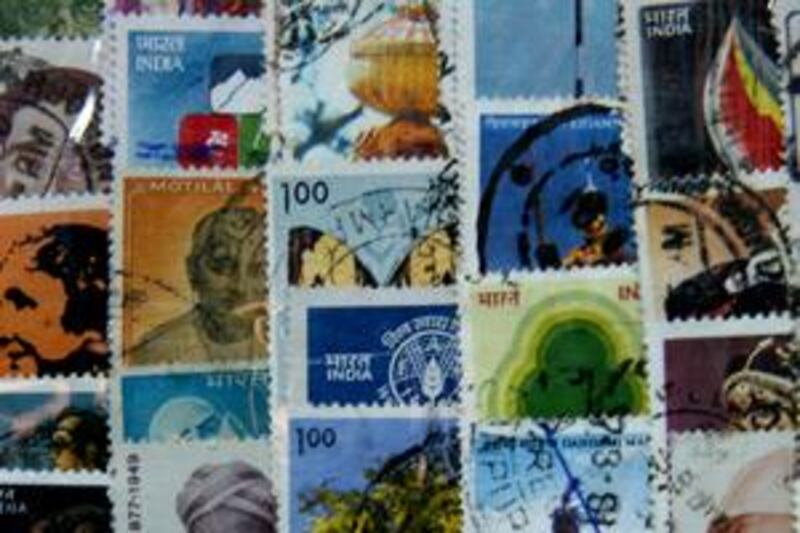Stamp collecting is a pursuit that combines elements of history, art and investment, all of which are quite respectable on their own. So why is the image of a hobbyist clutching a magnifying glass, painstakingly placing his latest purchase into an album a slightly depressing one?
Also known as philately, stamp collecting has been called trainspotting for people who don't like leaving the house. Perhaps the main reason for the stigma is that it's hard to understand how anyone can get excited about postal history in the first place. For most of us, stamps are like batteries or petrol: an expense that all must endure but few actually enjoy. And if enthusiasm for government-issue stationery isn't baffling enough, what about the multimillion-dirham price tags that rare stamps can command?
"Before I learnt about philately, I thought: 'They are collecting pieces of paper? What is this old rubbish? It's not useful!" says Awjad Lal Bakhsh Hussain, an officer at the Emirates Philatelic Association (EPA) in Dubai. "But then I learnt a different side of the story and all of the benefits," he says. "Collecting stamps is a passion." Philatelists believe that postage stamps can act as ambassadors, travelling the world and offering a unique view of life from within their countries of origin. A stamp's subject, design, colour and printing can speak volumes about its issuer, from its wealth to the way it sees itself. Philatelists view each tiny piece of paper as a jigsaw piece, containing a clue to the nation's economic, cultural, political and historical peculiarities.
In a country like the UAE, which exists without a full address system, you might question the need for postage stamps or assume that collecting would be a futile pursuit. But you would be wrong. Postage in the Emirates dates back to 1909, when the Indian Branch Post Office was opened in Dubai. In the Trucial States, each emirate began issuing its own stamps, resulting in a wave of variation that has never been seen again since.
For decades, the region's postal history was known only to a small number of wealthy private collectors and foreign historians. But in 1996, a ministerial decree led to the establishment of the EPA. The body is now the main hub for almost 250 area collectors and has a permanent home in the Bastakiya area in Bur Dubai. "A stamp is a small piece of art. There is a lot of work and effort to bring this design to the world," says Abdulla Mohammed Tayyeb Khoory, a 47-year-old Emirati businessman and the president of the EPA. "Whatever the issue is for, it gives you the message in one design. It will have a higher demand once it becomes older, just like art."
As well as heading up the EPA, Khoory is an internationally recognised stamp collector and competition winner. He specialises in the postal history of Dubai and has a complete set of Dubai stamps from 1909 to 1947. He also collects Abu Dhabi stamps, modern UAE issues and some Egyptian varieties. "I've been interested since childhood, maybe since I was five years old," he says. "When I started collecting stamps, I was just looking at the mail coming for my family members. I would cut the stamp away from the envelope and soak it in water, then dry it and keep it in an album."
Khoory doesn't know how many stamps he owns, but he admits that his obsession has led him to buy as many as 30 stamps a week. The collection now spans hundreds of albums and he refuses to admit how much he has spent on it. "It takes a lot of my time," he says. "My family lives with it. Sometimes I feel they are not happy with it. Why do I collect stamps when other people collect matchboxes or handbags? You'd have to ask a psychologist.
"It fulfils a need for me," he says, picking up a piece of paper carrying four tiny stamps that were sent from Dubai to Bombay in 1946. "Human beings have always had a general interest in collecting." Although the way Khoory speaks about his affection for stamps might seem strange at first, it can be inspiring. He clearly enjoys researching postal history every bit as much as adding his latest precious purchase to his collection.
"I have a lot of pieces that I love," he says. "I have the oldest known cover that was posted from Dubai to Bahrain. I cannot put a price on it." He also has the original proof of a famous 1977 stamp that was available for a single day before being withdrawn due to an error - a foreign company printed an incorrect date for the UAE's independence. But Khoory isn't the only collector in the UAE whose heart skips a beat at the sight of a rare stamp.
Muntaser Mustafa Hamoodi, a 35-year-old Iraqi, inspects a stamp carrying the image of a steam train. "I began collecting when I was 22, after my father gave me his collection," he says. "He collected stamps from Iraq and the neighbouring countries like Iran, Jordan, Turkey, Lebanon and Syria. Now I want to give my collection to my son, Yahia. He is only two years old, so he doesn't understand yet, but I will begin by giving him used stamps or ones with little value and ask him to put them in the correct categories."
As well as his personal collection of around 4,000 stamps, which he values at around $18,000 (Dh66,114), Hamoodi also resells stamps. He says he can make two or three times the price he paid for a piece only a few years earlier. "Sometimes I just buy a bag of used stamps still attached to the paper and sort through them," he says. "It is a fun thing to do." Hamoodi's wish to pass the collection he inherited on to his son highlights the deep gender imbalance that exists within the philatelic community, with an estimated male-to-female ratio of about 20 to one. But philately is becoming increasingly uncommon, not just among women, but also the young.
"Philately is in danger," says Khoory. "The average age of our group is about 40, which is much younger than a lot of other places in the world. When we were younger, there wasn't as much to do, but young people now are busy with a lot of things, like the internet and games, so they are not attracted to the stamps. The number of young collectors is much less." And in an age of e-mail, prepaid postage stickers and same-day courier services, could the common stamp, and by extension the philatelist, become endangered species? Hamoodi, Khoory and the other members of the EPA are concerned about their hobby's future, but perhaps for different reasons. Most philatelists believe there is a danger of too many new stamps being produced, not too few.
"There are places in Africa that will print anything on stamps if you give them enough money. In this region in the 1960s they issued stamps with JFK and Marilyn Monroe just to get the commissions," says Hamoodi. "That isn't philately; it's like playing cards." Prior to the formation of the UAE, many of the emirates gave printing contracts to foreign companies. This lead to a period during which the emirates' stamps often bore images commemorating scientific discoveries and political events in the West.
"They issued sets with nothing to do with the culture of the area - some even had nudity on them," says Khoory. "When the UAE was formed, it took a long time to cancel all of the agreements with the agents. Some took advantage of the grace period and flooded the market with stamps. They spoiled the image of the area. We hope that will not happen again." 1909 Postal services begin when the first branch post office is opened in Dubai. Like other postal agencies in the Gulf, it is run by the Indian Postal Administration, then under British rule, from Karachi. Indian stamps valued in rupees and annas are used.
1947 The Dubai branch post office is taken over by Pakistan after the division of India. Indian stamps overprinted with the word "Pakistan" are used. 1948 Dubai's postal administration is taken over by Britain. Stamps with portraits of the reigning monarchs, King George VI then Queen Elizabeth II, along with other images, come into use. 1963 British control of the postal service ceases and Dubai issues its first set of stamps on June 15. It had previously issued a set for use by the other emirates in 1961, but they are only used in Dubai because no other emirate has a post office.
1964 Abu Dhabi issues its first set of stamps on March 30. (Postal services in Abu Dhabi had been established the year before under the British Postal Agencies in Eastern Arabia, but the emirate would wait until January 1, 1967 to take over its postal service.) Post offices now open in Sharjah, Ajman, Ras al Khaimah, Fujairah and Umm al Qaiwain are linked to the Dubai Post Office and mail is dispatched through the airport. Each emirate begins to issue its own stamps.
1972 On August 1, the postal service of the United Arab Emirates is united and the General Post Administration is established under the Ministry of Communications. Abu Dhabi's stamps are overprinted with the words "United Arab Emirates" for use in all the emirates. 1973 The first UAE stamps are issued by the General Postal Administration on January 1. The set includes a portrait of Sheikh Zayed, the founding President of the UAE.





